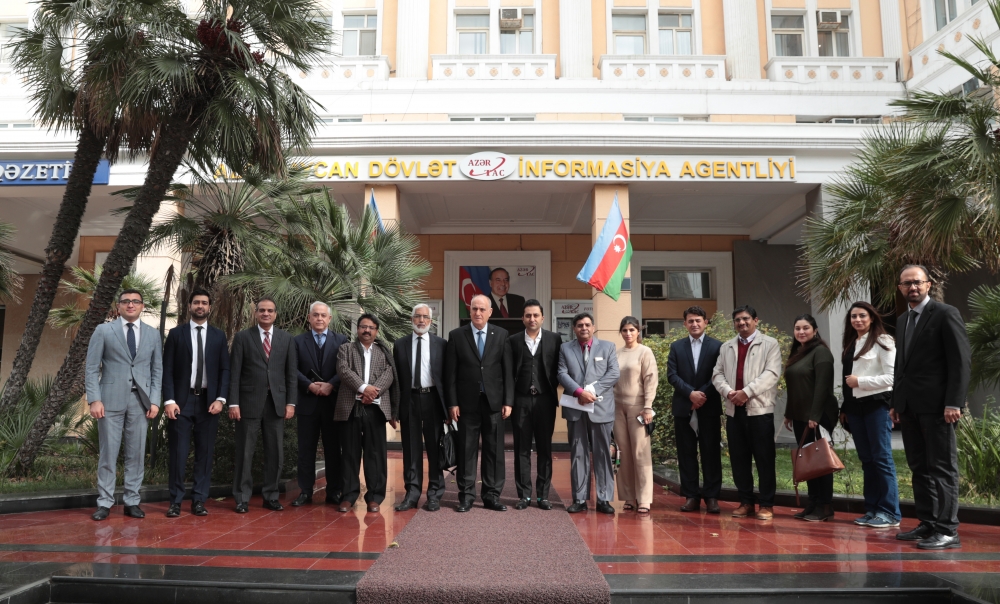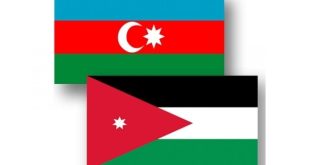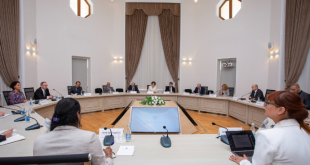
Pakistani journalist, Editor-in-chief of DND news agency Agha Igrar Haroon made a report “Ohhhh My Shusha— I am here – I am here to celebrate your Liberation” about his visit to Karabakh and Shusha. On November 3-6, together with other representatives of the Pakistani media, he visited Azerbaijan. The journalists held a number of meetings in Baku, as well as at AZERTAC. They made a trip to the liberated from the Armenian occupation territories of Azerbaijan. AZERTAC presents an article by a journalist.
On November 3, 2021, when I was leaving my residence for my journey to Shusha, I was going through the fatigue of Dengue fever that I had gone through less than a week ago, I was a little scared while thinking about the journey to Baku would be too long —-long enough to consume mine already under stress body. Reaching airport three before the flight, over six-hour flight to Istanbul while flying over to Baku, fix hour layoff transfers and then over 3-hour flight from Istanbul to Baku and then the process of going through passport control and then getting luggage and then reach to the hotel—- Just image how many hours in the journey were waiting for me?
All went well and I reached the Hotel around 2300 hours of Baku time. The strength of this long journey was the wonderful company of members of our delegation and our host——-
November 4 was packed with meetings and visits. The day started by visiting the head office of ASAN— a service launched by President Azerbaijan to facilitate people. This service is quite similar to our NADRA but not confined only to services NADRA provides us. It offers so many more services including promotion of handmade products, offering guidance for soft loans for cottage industry, renewal of driving licenses etc.
We were briefed by Asif Azizov, Chief Adviser on International Relations, State Agency for Public Service and Social Innovations under the President of the Republic of Azerbaijan about the goal of the Agency, and he explained that the agency’s goal is to make services more easily accessible to citizens using modern technologies. The acronym “ASAN” stands for “Azerbaijan Service and Assessment Network”. The word “asan” means “easy” in the Azerbaijani as well as in Urdu languages.
He informed us that ASAN service, as part of the State Agency for Public Services and Social Innovations under the President of the Republic of Azerbaijan,
“ASAN service” centers are “one-stop-shop”-based locations that bring together representatives of 10 government entities and private companies providing services in a public-private partnership. More than 300 services are provided, including birth, death, and marriage registration; identity cards; passports; driver licenses; real estate records; immigrant status, and other civic services. At the same time, functional support services, including banking, insurance, legal support, translation, and other services are rendered at the center.
He was of the view that the ASAN services in the centers are (were) rendered based on the “single space” approach. Thus, a citizen can benefit from various public and private services in one center (single administrative building) at the same time entering through only one door.
The next journey was with the offices of the Foreign Ministry of Azerbaijan where the Deputy Foreign Minister and his staff greeted us and Deputy Foreign Minister Elnur Mammadov, Deputy Foreign Minister gave us a detailed briefing about the Armenia—Azerbaijan dispute, the liberation of illegal occupied lands from Armenia during 44-days Patriotic War and dynamics of Azerbaijan-Pakistan Foreign relations. He lauded the moral support of the Pakistan government as well as of the Pakistan nation since the independence of Azerbaijan and stated that Pakistanis are (were) brothers not only friends. He explained the historic perspective of the standing of Islamabad with Baku always at all international forums including the UN Security Council over the former Nagorno-Karabakh issue (now there is no more Nagorno — it is now only Karabakh region liberated by Azerbaijan).
His briefing was very helpful to understand the volume of destruction and genocide Armenians committed during the 30-year illegal occupation on Azerbaijani lands. Apart from residential and administrative buildings, according to the official sources, 700 historic and cultural monuments were damaged or destroyed; 927 libraries; 808 cultural centers; 85 music and art schools; 22 museums with over 100,000 artifacts; 4 art galleries, 4 theatres, 2 concert halls totally destroyed in these territories over the last thirty years. During the 44-days war, Azerbaijan liberated over 300 settlements, including the cities of Jabrayil, Fuzuli, Zangilan, Gubadli, and Shusha, from nearly 30-year-long illegal Armenian occupation.
The briefing also highlighted that Azerbaijan is following a multipronged strategy to develop liberated regions —the construction and minesweeping that is necessary to start developmental works. There are over one million anti-personnel and anti-Tank mines planted by Armenia in formerly occupied territories while Armenia says that it has planted over 92,000 anti-personnel mines in the Fuzuli and Zangilan regions while surrounding the areas to Azerbaijani army during the historic Armenian defeat. However, Azerbaijan believes that maps provided by Armenia on July 3, 2021, upon the initiative of the Russian Federation are not complete and the total number of landmines planted by Armenia is much larger than it (Armenia) it is claiming. Azerbaijan believes more than one million landmines are planted in occupied Azerbaijani territories over nearly 30 years by Armenia.
After this important meeting and briefing, the next destination was the offices of State-Run News Agency AZERTAC where Aslan Aslanov, Board chairman of AZERTAC, Suleyman Ibrahimov, head of international relations department and Elshan Shahbalayev, editor-in-chief, multimedia and information resources department greeted the Pakistani delegation and briefed us about the role of AZERTAC in spreading information about Azerbaijan world over.
Chairman of the Board of Azerbaijan State News Agency (AZERTAC) Aslan Aslanov highlighted strong ties of Azerbaijan and Pakistan and stated that both had always supported each other at all levels.
“Your visit to Azerbaijan on the eve of the Victory Day is very symbolic. During the Patriotic War, Pakistan provided great support for Azerbaijan. Under the leadership of Commander-in-Chief, President Ilham Aliyev, our army liberated our lands and ended 30 years of occupation. During these years, Armenia destroyed mosques, houses, and all infrastructure in these territories. You will see all this with your own eyes during your visit to the liberated territories. You will also witness the large-scale construction work started in these territories,” said Aslan Aslanov.
Enjoying Azerbaijani tea with Sheerni (local sweets), participants of the Pakistani delegation expressed their viewpoint that media-to-Media interaction can help for enhancing people-to-people contact.
Here I must mention that Chairman of the Board of Azerbaijan State News Agency (AZERTAC) Aslan Aslanov is the person who introduced me dynamics of Azerbaijan-Armenia contra years ago when we met and he briefed me on how Armenia had been doing the genocide of Azerbaijanis. He is the person who ignited my desire to visit Shusha someday and this visit made this desire a reality. Aslan Aslanov is a living encyclopedia of Azerbaijani history and Azerbaijan and Pakistan bilateral relationship. If you have time, just sit with him and let me explain and you can write books on Caucasian dynamics and Azerbaijani history. When I was standing at the gate of Shusha, the face that was in my eyes was of Aslan Aslanov.
Our next destination was the Embassy of Pakistan where Ambassador Bilal Hayee along with his team were waiting for us. A polite thin personality with a strong knowledge of the Azerbaijan-Pakistan bilateral relationship showed us Embassy and also invited us to an awesome Azerbaijani lunch. At lunch, he explained the initiative he has been taking to enhance trade volume between the two countries and his constant support to Pakistani students who are studying in different institutions in Azerbaijan. He was of the view that there was a great potential for enhancing trade for genuine businessmen and traders. His pleasant personality gave encouragement for asking more and more questions and spending over three hours with him was a great volume of time by receiving in-depth knowledge about possibilities of further enhancing people-to-people contact and initiative taken by Prime Minister Imran Khan for broadening trade with friendly countries.
Ambassador Bilal Hayee invited the delegation to the Pakistan Cultural Centre (PCC) that was formally inaugurated at the Azerbaijan University of Languages (ADU) on July 31, 2021.
The idea of the Pakistan Cultural Centre was conceived by Ambassador Bilal Hayee after his meeting with the Rector of ADU. Later it was implemented with the help of the Azerbaijan University of Languages.
The key objectives of the Pakistan Cultural Centre include the promotion and projection of Pakistan’s diverse and rich culture. It is also expected that in the future, the teaching of the Urdu language and Pakistan history would commence from the platform of the Pakistan Cultural Centre. The Center is also geared to create awareness among the Azerbaijani youth about Pakistan’s beautiful landscape, ancient heritage, modern urban centers, and huge economic potential.
In this center, a special corner is established where the scholarly work of Allama Muhammad Iqbal is exhibited. Students and staff of ADU have shown profound interest in the arts and books on Pakistan. Around 40-50 people visit the center on a daily basis. They are briefed on the rich and diverse culture of Pakistan and tourism potential. This center is the first solid platform in Baku to project Pakistan’s culture, heritage, and tourism. This will also advance our brotherly relationships with Azerbaijan to a new high.
Saying Goodbye to Ambassador Bilal Hayee at Pakistan Cultural Centre was not the end of the day for the Pakistani delegation because visits to Haider Alieve center and Military museum were awaiting us
This was my fourth visit to Heydar Aliyev Center.
The Heydar Aliyev Center is a 57,500 m2 (619,000 sq ft) building complex in Baku, Azerbaijan designed by Iraqi-British architect Zaha Hadid and noted for its distinctive architecture and flowing, curved style that eschews sharp angles. The center is named after Heydar Aliyev, the first secretary of Soviet Azerbaijan from 1969 to 1982, and president of Azerbaijan Republic from October 1993 to October 2003.
The next and the last visit of the day was at Army Museum. I have given a name to this place as “Graveyard of Armenian Army” and this graveyard has been established in Baku at Sahil side where you can find children and families come almost every day to see dead tanks, armored vehicles, and many other military gears that Armenian Army left behind during the historic defeat in 44-days War.
While visiting this graveyard, I felt that live nations fight to reclaim their lands instead of sitting and crying over the deafness of international bodies like the United Nations. We remember that there were several UN Security Council resolutions waiting for justice in reference to Armenian occupation and aggression against Azerbaijan but nothing was happening till such time when the brave Azerbaijani armed forces through their mussels Implemented UNSC resolutions and reclaimed illegally occupied territory during 44-days
The Patriotic War under the leadership of the Supreme Commander-in-Chief of the Armed Forces of the Republic of Azerbaijan, President İlham Aliyev that ended with a victory of the brave Azerbaijani Army, opened a new era in the history of the Republic of Azerbaijan, established international justice and changed the realities in the region.
After completing the hectic day, I came back to my hotel Hyatt Regency but had no energy to sit anywhere and enjoy the ambiance of this beautiful Hotel because our journey to Shusha was awaiting and we were told to sit in vehicles at 8 am next morning (November 5). A day ended but another day was waiting for me to realize my dream come true to reach Shusha—
On November 5, 2021, early morning we were on the highway from Baku to Shshua via Jabrayil and Fuzuli.
Fuzuli—- the city of Umud Mirzaev and many more friends. The Fuzuli was introduced to me years ago by IEPF President Umud Mirzaev who while remembering his village could not stop crying. When I was traveling to Fuzuli, I was thinking about my first meeting with IEPF Umud Mirzaev, an interesting friendly personality with deep eyes. We became good friends during our first meeting and I still remember several stories of Fuzuli he narrated to me in our first meeting. I sent a message to Umud— dear friend soon I would be in your village— in the world of your memories.
Our first stop was at a village where were briefed about minesweeping with a live demonstration of how mines are being neutralized. One should remember that Armenia installed over one million anti-tank and anti-personnel mines in territories under its 30 years’ illegal occupation. Now brave Azerbaijanis are clearing their land by risking their lives from these horrific landmines.
Our next destination was Jabrayil where I came out of the vehicle to visit a nearby graveyard. When I came out of my vehicle and entered Jabrayil graveyard, I saw huge destruction —- excavated and destroyed graves. The scene was so overwhelming my voice choked in my throat. I could not cry even. Only tears were flowing out of my eyes.
My legs became lifeless and I could not stand anymore. I had no option just to sit near the remains of a grave and keep my eyes closed to feel what could happen here years ago? Why these graves were destroyed? What happened to these dwellers of the locality of the last resting place of human beings? What did happen to those who came here for their ultimate rest in their graves?
How could a human dig grave of someone just in religious hatred or in quest of taking away a single gold tooth? How could anybody destroy already destroyed persons?
Digging was so intense that there are almost no graves that remain intact and one can find human bones spreading all over the graves.
I do not have words to describe what I had seen at several cemeteries and I can imagine the level of barbarisms of Armenians by observing how did their ruin even cemeteries. It is as if they tried to take revenge on the dead. This is the most gruesome way of vandalism. I believe that the international community should see this brutality that Armenia caused for years.
I found several “ghost towns” along with newly built road from Baku to Shusha and I saw ruined graves, turned into piles of stones, and wrecked cemeteries since the graveyards have become unrecognizable, causing deep pain for those whose elders were buried in these graves who are just now debris, not graves. Umud Mirzaev was right that Armenian barbarism is beyond explanation.
While traveling to Fuzuli Airport, my mind was still thinking about those who were vandalized in their graves— Humanity shames on them who did it.
We reached Fuzuli Airport in the afternoon. Fuzuli is around 300 KM away from the capital. The city of Fuzuli was known as Qarabulaq until 1827 then it was renamed Karyagino in honor of Russian colonel Pavel Karyagin. It was an administrative unit of Dzhebrail Uyezd during the Russian Empire. The town was renamed Füzuli in honor of the poet Fuzuli in 1959. During the Soviet years, the city was the administrative center of the Füzuli raion of Azerbaijan SSR.
Muhammad bin Suleyman better known by his pen name Fuzuli (1494 – 1556), was an Azerbaijani, of the Bayat tribes of Oghuz, poet, writer, and thinker. Fuzuli wrote his collected poems (divan) in three different languages: in his native Azerbaijani, Arabic, and Persian.
During a briefing, I came to know that the Fuzuli airport is constructed in accordance with the highest international standards, and the first test flight to Fuzuli was performed on September 5, 2021, when the largest passenger aircraft of AZAL, Airbus A340-500, landed at the airport. Its apron area is 60 thousand square meters; it is designed for the parking of eight aircraft. The Air Traffic Control (ATC) tower is equipped with automated ATC systems that would help for the night landing of all kinds of aircraft.
The runway of the airport is 3,000 meters (9,843 feet) long and 60 meters (197 feet) wide. Its terminal can serve 200 passengers per hour and all wide-body aircraft, including large cargo aircraft, can use this airport. The construction was started on January 14, 2021, and was inaugurated on October 2021, 26 by the presidents of Azerbaijan (Ilham Aliyev) and of Turkey (Recep Tayyip Erdogan). According to available data, the construction cost of the airport was 75 million manats ($44 million).
The airport is 100 KM away from the historic city of Shusha and will be the gateway of tourism in the entire region.
Our next stop was Shusha and now we were traveling on Victory Road. The construction of two-lane Victory Road began 10 months ago and the work was completed on a 101-km long patch. It starts from the Hajigabul-Minjivan-Zangazur corridor and stretches to Shusha, the main city of Karabakh.
The Victory Road passing through the territory of Fuzuli, Khojavand, Khojaly, and Shusha districts now connect more than 20 settlements, including the cities of Fuzuli and Shusha.
When we reached Shusha, it was already evening and the weather was misty. Shusha in Karabakh was under Armenian occupation from 1992 till it was liberated from occupation in 2020, during the second Karabakh war. Following the liberation, Azerbaijan launched the construction of the “Victory Road”.
Spending a misty night in Shusha had several wonderful experiences including enjoying a lavish unending dinner, facing internet and connectivity problems, laughing and joking with friends, and walking through misty streets around the historic establishments.
The day was over but with a tight schedule for the next day— A visit to a place from Azerbaijani special forces climbed over to Shusha and defeated Armenians in a ruthless way. Crossing and climbing over a 2500 meter steep ridge by Azerbaijani special forces would be remembered as an interesting chapter in the books of War Histories.
The journey of November 6, 2021, started after breakfast and we reached a plateau— A Maidan which became the last battlefield between Armenian forces and Azerbaijani special forces. Here we were briefed by Zaur Hasanov, Special Representative of the President Ilham Aliyev in Shusha about the last battle of Shusha— and how the Shusha was won?
Zaur Hasanov was eager to answer any question though he was very busy in other arrangements of the visit of the President of Azerbaijan to the same place where we were standing the next day to celebrate the first anniversary of Shusha liberation and Zaur Hasanov was the head of all arrangements.
He showed us ridges and ravines Azerbaijani special forces closed to reach Maidan and attacking Armenian forces when they could not imagine that their fate in Shusha had ceased forever.
Now our next destination was the Fortress of Shusha— The Gate of the ancient city of Shusha—that I had been dreaming of for ages.
After visiting the Old Mosque of Shusha where I performed Zuhr Namaaz, we were walking through destructed buildings, reaching the Gate of Shusha.
Stunned, excited, voiceless, and might be breathless—I was standing at the Gate of Shusha.
I closed my eyes and was talking with every brick of Shusha and said:
Ohhhh My Shusha— I am here – I am here to see you liberated—I am here to touch my forehead to your soil— My journey is over—Oh Shusha I remembered you for years before reaching you. I hope you would remember me also after this first meeting. I know the soul of Shusha has accepted me and would invite me again and again.
 Oval Useful news from Azerbaijan and Caucasus
Oval Useful news from Azerbaijan and Caucasus


